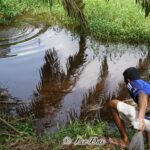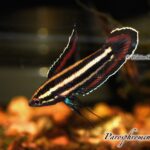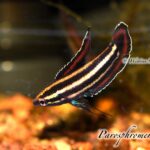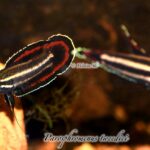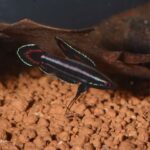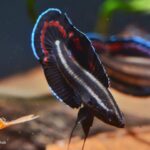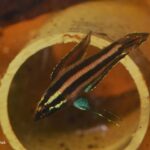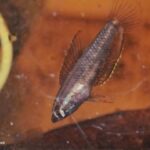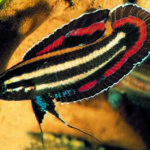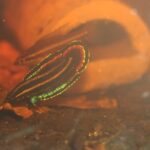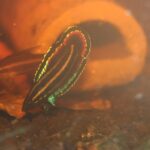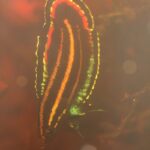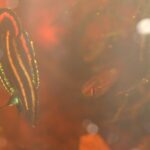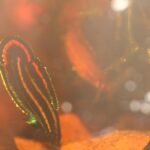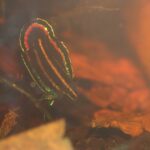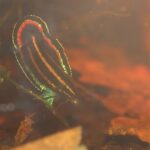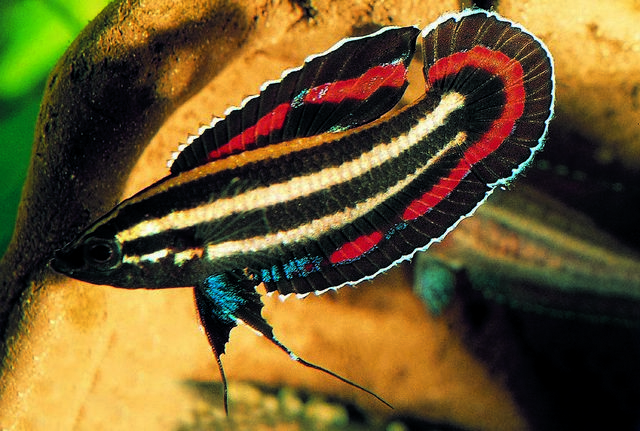
Kottelat & Ng 2005
First description: Diagnoses of six new species of Parosphromenus (Teleostei: Osphronemidae) from Malay Peninsula and Borneo, with notes on other species. The Raffles Bulletin of Zoology 2005 Supplement No. 13: 101-113.
Characteristics: Round-tailed licorice gourami of the bintan-harvey type. Total length max. 4.0 cm. Fin formula: Dorsal: X-XII, 6-7, total 17-19, anal fin: X-XII, 10-13, total 21-23. Among all red-finned licorice gouramis this is the one with the largest fraction of red. The typical tweediei male shows strong red unpaired fins, which are bordered by broad black bands and white edges. The ventral fins are blue with long black filaments.
The body stripes are black, so are head and throat. The red areas in the dorsal and anal fin can be replaced by a blue band, especially in the front part. The dorsal fin is usually slightly pointed, but not extremely long, the caudal fin is rounded. The females show a less pointed dorsal fin and generally transparent, only slightly brownish coloured unpaired fins; only in aggressive mood do their colouration patterns resemble those of the males.
P. Beyer has discovered during repeated visits of today´s relict habitats since 2006 that the species has a significant colour variability, which goes far beyond the moderate variability, named in the first description. In some years or seasons there were more “red”, in others more “blue” (=fish with a high amount of blue colouration). Beyer assumes that this effect is based on changing food composition.
The species has been known much longer than its relatively late first description suggests. According to M. Kottelat this species was usually meant when older aquaristic literature mentioned P. “deissneri”, found in West-Malaysia. Also the fish that W. Foersch received in the beginning of the seventies through an import company in Munich and later through Dietrich Schaller from Johore, were most likely tweediei. These forms, with which he carried out his experiments in the belief they were “deissneri”, had relatively large amounts of blue colouration in their fins. Schaller asked the former keeper of the Raffles Museum Singapore, Eric Alfred, about the locality of the then little known “deissneri” and was told they were coming from “Ayer Hitam”. Here, he indeed found the fish, but this terra typica of tweediei is destroyed today.
Similar species: risk of confusion is low for the males, but principialy not to be excluded for other red-finned licorice gouramis. This is due to the fact that different large blue areas may be present in the fins of tweediei. A good feature for differentiation of the males is the presence of white bands occuring in caudal and dorsal fin. The form spec. Langgam from Sumatra is very similar, but its fin edges are often not pure white and the caudal fin is pointed in the end. In the females the risk of confusion with other round-tailed species is high, but on the other hand, dominant females can also show a less distinct male-like colouration.
Occurrence / Distribution: West-Malaysia, Johore district; in earlier times also further north in the district Malakka. These populations do not exist anymore, due to habitat destruction. Tweedie listed a number of areas of occurrence in West-Malaysia in 1952 for “deissneri”. Many of these places were apparently related to the species, named after him, but most of them are destroyed today, such as the main location Ayer Hitam. In the nineties, mainly red-finned fish have been imported from the area around Pontian, at this time the then undescribed species was named spec. Pontian. The fact that in far away Sumatra a very similar form (spec. Langgam) has been found, is most likely going back to convergent development. Both forms should not be species-identical.
Threat: very high, because none of the originally existing habitats remained untouched by human influences. The species can be found (only?) in strongly affected structures (e.g. roadside channels), which are still fed by relict blackwater springs. If there is a correlation between the instability of these water bodies and the striking variability of the colouration of the fish is unclear. Beyer suggested the influence of changing food. The expedition Bussler/Hinz in April 2011 could not find this species (as the only kind of sought species in West-Malaysia) in places, which had been visited last by Beyer .
Discovery/First import:The fish, introduced by Herre to the United States in 1937 as “deissneri”, belonged most likely to this species, as well as the fish imported to Germany by Schaller in 1973. Kubota, Kopic and others have spread this species in the mid-nineties.
Trade: This attractive species in particular has been traded very sporadically (as “deissneri”) since the seventies, when the main habitats were still intact, mainly as a by-catch. Today this is rarely the case, and it has been seen no longer in recent years. This is clearly due to the significant decline of the stock in the still populated relict habitats.
Care / Breeding: not different from other licorice gouramis. Since the classic description of Foersch from 1974 (“Notes on care and breeding of Parosphromenus deissneri”), is related to this species and the basic knowledge about Parosphromenus care and breeding goes back to this publication, P.tweediei is the species for which the most thoroughly researched experience is available. At the partly destroyed fishing grounds in Pontian, values of pH 4.0 were measured. The fish have been caught in depths of 1.0 to 1.5 meter in dense underwater vegetation (Kottelat & Ng 2005:107). Strong animals can produce large clutches (50 to 80 eggs).
Behaviour / Particularities: Head-down or horizontally courtship. Dominant females can take on a male-like colouration in the absence of males, especially in small groups. The species is one of the most attractive and sought after in the aquarium, however, it requires a strict observance of the principles of Licorice gouramii aquatics.
PF
Parosphromenus tweediei Gallery
Parosphromenus tweediei (Ruinemans 2013)


